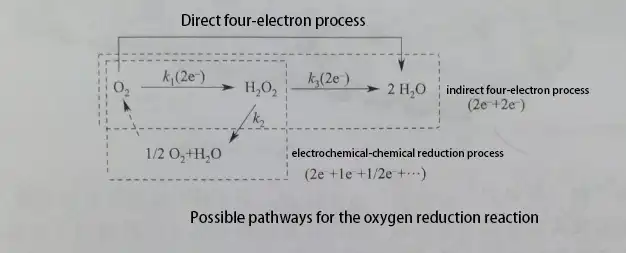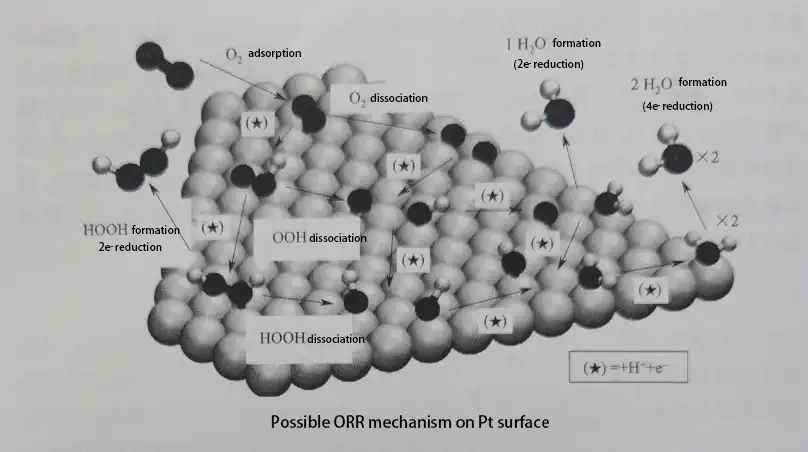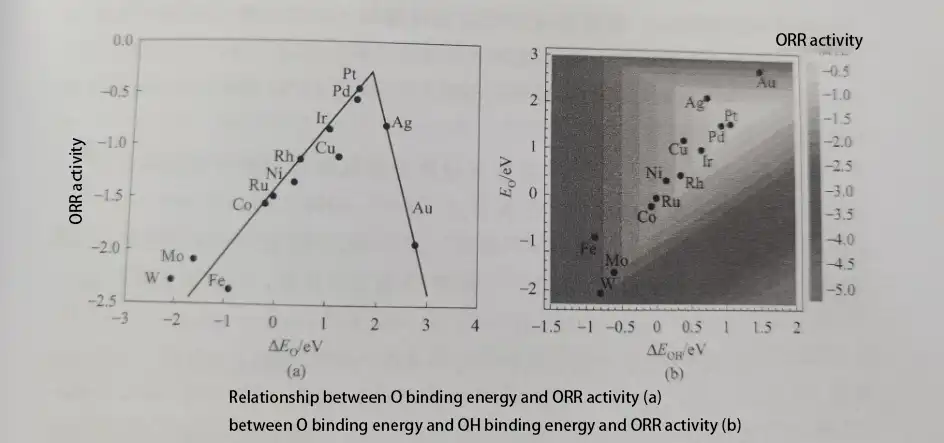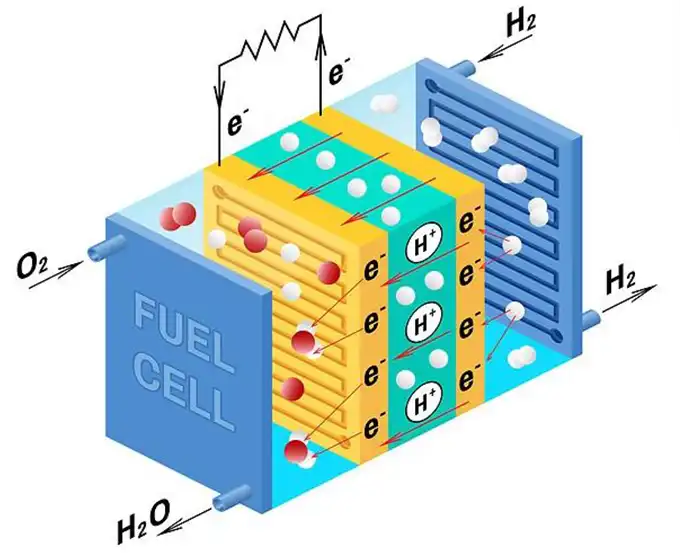As the world’s energy landscape undergoes transformation and the goals of “carbon peaking” and “carbon neutrality” are proposed, hydrogen energy, with the highest mass energy density and zero carbon emissions, has garnered increasing attention. Proton exchange membrane fuel cells (PEMFCs) are currently a highly promising hydrogen energy utilization technology due to their low operating temperature, fast start-up, and pollution-free advantages, making them widely applicable in aerospace, marine vessels, automobiles, stationary power sources, and many other fields.
Note: Detailed applications of proton exchange membrane fuel cells.
To date, platinum-based catalysts remain the primary choice for catalysts in PEMFCs due to their superior oxygen reduction reaction (ORR) and hydrogen oxidation reaction (HOR) performance. However, platinum is a scarce and precious metal, and its high cost restricts the commercialization of fuel cells. According to the U.S. Department of Energy (DOE) 2022 forecast for hydrogen fuel cell heavy trucks, when the annual shipment of PEMFC stacks reaches 50,000 units, the cost of catalysts will account for 59% of the total production cost of the stacks.
The oxygen reduction reaction (ORR) is one of the core steps in the entire electrochemical process, having a decisive impact on the output voltage and efficiency of fuel cells. However, the catalyst amount for ORR is relatively high, estimated to account for 80% or more of the total amount. Additionally, its reversibility is poor, polarization is severe, and the kinetic process is a complex four-electron process. Various intermediate species are involved in the reaction, such as H2O2 and oxygen-containing adsorbed intermediates (O2,ad and OHad, etc.). These intermediates cause the overpotential in the ORR process to reach up to 0.2V or even higher. Therefore, developing highly active low-Pt-loading ORR catalysts is crucial to promote the large-scale application of fuel cells.
Currently, there have been numerous reports on the ORR mechanism and experimental research, but they all vary slightly. These include:
Two-electron pathway: This mainly involves two primary steps: partial reduction of the oxygen molecule to produce hydrogen peroxide, which is then further reduced to water. This mechanism can be represented by the following steps:
O2+2H++2e–→H2O2
H2O2+2H++2e–→2H2O
This pathway is also known as a two-step four-electron process, with hydrogen peroxide (H2O2) as the intermediate. The presence of hydrogen peroxide can lead to catalyst poisoning and efficiency reduction.
Sequential single-electron pathway: In this pathway, the reduction of the oxygen molecule occurs through consecutive single-electron transfer steps, each forming a single-electron intermediate, such as:
O2+e–→O2–
O2–+e–→O22-
O22-+e–→2O–
2O–+4H++2e–→2H2O
This pathway involves multiple single-electron transfer steps, producing various intermediates, which complicate the reaction process.
Direct four-electron pathway: This is the most ideal reaction pathway because it avoids the formation of harmful intermediates and directly reduces the oxygen molecule to water:O2+4H++4e–→2H2O
Stepwise four-electron pathway: In this pathway, the oxygen reduction process can be broken down into several smaller steps, each involving the stepwise addition of protons and electrons, forming different intermediates:
O2+H++e–→HO2
HO2+H++e–→H2O2
H2O2+H++e–→HO+H2O
HO+H++e–→H2O
This pathway illustrates the stepwise addition of protons and electrons, as well as the formation and conversion of various intermediates.
The above explanations mainly revolve around the “four-electron process” theoretical studies. There are many other different theoretical studies, which will not be detailed here. The various research theories on the oxygen reduction reaction (ORR) demonstrate the complexity and diversity of the reaction pathways, with the direct four-electron process being the most ideal pathway.
In the direct four-electron reaction process, O2 first adsorbs onto the surface of the electrocatalyst, forming adsorbed oxygen. The adsorbed oxygen reacts through different pathways: When the adsorbed oxygen is directly electrochemically reduced to H2O via the four-electron pathway, it is called the “direct four-electron process.” When the adsorbed oxygen forms the intermediate product H2O2 via the two-electron pathway and H2O2 desorbs directly from the catalyst surface, it is called the “two-electron reduction process.” If H2O2 continues to be reduced to H2O, it is called the “indirect four-electron process” or “H2O2 process.” If H2O2 decomposes on the electrocatalyst surface (catalytically or chemically) into H2O and O2, and the resulting O2 continues the O2 reduction reaction, this process is called the “electrochemical-chemical reduction process.”

ORR Mechanism on PT Surface
The complex ORR process involves multiple steps of electron and proton transfer. By studying this process, one can determine the rate-determining steps of ORR kinetics and identify the causes of overpotential. Therefore, understanding the ORR process at an atomic level is crucial for designing high-performance electrocatalysts. There has been extensive research on the reaction mechanisms of ORR on different electrocatalyst surfaces, with Pt/C still being one of the electrocatalysts with high ORR catalytic activity. Consequently, the reduction reaction mechanism of O2 on the Pt electrocatalyst surface has been the most extensively studied.
There is a comprehensive understanding of the relationship between ORR reaction kinetics and the electronic properties of metal surfaces. However, future research needs to continually deepen to develop more efficient and stable ORR catalysts. The research on the ORR mechanism can be summarized as follows:
Firstly, O2 diffuses to the electrocatalyst surface, forming adsorbed oxygen molecules (O2*, where * represents active sites on the catalyst surface). Based on the O-O bond cleavage steps, the reduction mechanism of O2* can be divided into three pathways:
Dissociative Pathway: The O-O bond directly breaks to form O* intermediates, which are subsequently reduced to OH* and H2O*.
Associative Pathway: O2* is first reduced to OOH*. Then, the O-O bond in OOH* breaks to form O* and OH* intermediates, which continue to be reduced.
Peroxide Pathway (Secondary Associative Pathway): O₂* is sequentially reduced to OOH* and HOOH* before the O-O bond breaks to form OH*. The intermediates continue to be reduced.

Intermediates such as O*, OOH*, and OH* are crucial in the ORR process. Direct experimental evidence for these intermediates is challenging to obtain, but theoretical calculations have provided substantial evidence. Researchers have used density functional theory (DFT) calculations to demonstrate that the adsorption of oxygen species on the electrocatalyst surface is the cause of overpotential. At high voltages, oxygen adsorbed species on the electrocatalyst surface are stable, making proton and electron transfer difficult. When the voltage decreases, the stability of the adsorbed oxygen decreases, allowing the oxidation reaction to occur.
The bond energy between oxygen species and the electrocatalyst surface directly determines the catalytic activity of the electrocatalyst. For a highly active electrocatalyst, the bond energy between the surface and intermediate products should be appropriate: if the adsorption bond energy is too weak, it will hinder the transfer of electrons and protons to the adsorbed oxygen; if the adsorption bond energy is too strong, the produced H2O will be difficult to desorb, occupying active sites and preventing further adsorption of O2, thereby reducing the ORR activity of the electrocatalyst.
The fundamental reason for the difference in bond energy between intermediates and different electrocatalyst surfaces lies in the electronic structure relative to the Fermi level (the highest occupied orbital). The higher the position of the metal d-band, the stronger the interaction between the electrocatalyst surface and the intermediates. Therefore, when the bond energy between the intermediates and the electrocatalyst is appropriate, the electronic structure is optimized, resulting in higher ORR catalytic activity.
The relationship between the bond energy of adsorbed species (O*, OOH*, OH*) on different metal electrocatalyst surfaces and the oxygen reduction activity forms a “volcano plot.” Among many metals, Pt, compared to other metals (such as Fe, Co, Ni, etc.), has a relatively suitable bond energy strength with O*, OOH*, and OH*, leading to high ORR activity.

According to this plot, we can see that the bond energy between Pt and adsorbed oxygen is not the most optimal, but an electrocatalyst with slightly weaker bond energy than Pt would exhibit higher ORR activity. Specifically, when the adsorption bond energy is weaker by 0.2 eV compared to Pt, the electrocatalyst will have the highest ORR activity.
Oxygen Reduction Reaction of Non-Precious Metal Electrocatalysts
The application of non-precious metal electrocatalysts in the oxygen reduction reaction (ORR) is of significant importance due to their low cost and abundant resources. Significant progress has been made in studying the ORR mechanism of non-precious metal catalysts (NPMCs), though mainly in laboratory settings. To achieve large-scale application, continuous in-depth research is needed to address many technical challenges. Here are some major advancements and research hotspots in this field:
Material Design and Synthesis:
Researchers are enhancing ORR activity and durability by designing and synthesizing novel non-precious metal catalysts. For example, metal-organic framework (MOF)-derived carbon-based catalysts and nitrogen-doped carbon materials (Fe-N-C, Co-N-C) have shown high catalytic performance.
Structural Characterization and Mechanism Analysis:
Advanced characterization techniques, such as X-ray absorption spectroscopy (XAS), transmission electron microscopy (TEM), scanning electron microscopy (SEM), and X-ray photoelectron spectroscopy (XPS), are used to study the microstructure and surface properties of catalysts. These techniques help understand the active sites, catalytic mechanisms, and degradation pathways of the catalysts.
Theoretical Calculations and Simulations:
Density functional theory (DFT) and molecular dynamics (MD) simulations play a crucial role in understanding the ORR mechanism. Through computational simulations, researchers can predict active sites, reaction pathways, and energy barriers, guiding the design and optimization of catalysts.
Practical Application and Performance Evaluation:
Performance testing of non-precious metal catalysts in practical applications, such as fuel cells and lithium-air batteries, is a key research focus. Long-term stability tests and performance evaluations under actual operating conditions verify the practicality and reliability of the catalysts.
Degradation Mechanism Research:
To improve the durability of non-precious metal catalysts, researchers are exploring the mechanisms of catalyst degradation. Understanding the causes of degradation, such as metal ion leaching and carbon matrix corrosion, helps in designing more stable catalysts.
ORR Mechanism of Non-Precious Metal Electrocatalysts
For transition metal-nitrogen-carbon catalysts (M-N-C), researchers believe their catalytic mechanisms are similar. Taking Fe-N-C as an example, the ORR catalyzed by Fe-N-C starts from divalent Fe, which might begin as N4FeII-OH2 under acidic conditions. O2 adsorbs onto N4FeII-OH2 while gaining an electron and a proton, as shown in the following equation: N4FeII-OH2-OH2+O2+H++e–→N4FeIII-O-OH+H2O. The reaction can then proceed via two pathways:
Pathway 1: N4FeIII– O – OH gains a proton and an electron, releases a water molecule, and forms a high-valent Fe-oxo species. It continues to gain electrons and protons, eventually returning to the hydrated divalent Fe form. The specific steps are as follows:
(1)N4FeIII-O-OH+H++e–→N4FeIV=O+H2O
(2)N4FeIV=O+H++e–→N4FeIII-OH
(3)N4FeIII-OH+H++e–→N4FeII-OH2
Pathway 2:N4FeIII-O-OH gains a proton and an electron to form H2O2, and the catalytic active site, after adsorbing a water molecule, returns to the hydrated divalent iron form, as follows:
(1)N4FeIII-O-OH+H++e–→N4FeII+H2O2
(2)N4FeII+H2O→N4FeII-OH2
In Pathway 1, O2 directly gains four protons and four electrons, which is the direct four-electron pathway of ORR. This pathway necessitates the formation of a tetravalent Fe intermediate. In Pathway 2, O2 only gains two protons and two electrons, corresponding to the two-electron pathway of ORR. Some researchers suggest that tetravalent Fe is possible in Fe-N-C catalyzed ORR but only under high overpotentials. This might explain why Fe-N-C catalysts follow a direct four-electron pathway at high overpotentials and a two-electron pathway at low potentials. According to this view, since CoN4 is less likely to form high-valent Co states, ORR catalyzed by CoN4 typically follows the two-electron pathway, generating H2O2.
Conclusion:
As the global energy paradigm shifts towards sustainability and the targets of “carbon peaking” and “carbon neutrality” are established, hydrogen energy, particularly through proton exchange membrane fuel cells (PEMFCs), stands out as a pivotal technology. Despite the challenges posed by the reliance on platinum-based catalysts, significant advancements in understanding the oxygen reduction reaction (ORR) and the development of non-precious metal catalysts (NPMCs) are paving the way for more efficient, cost-effective solutions. By continuing to explore and innovate in catalyst design, synthesis, and mechanistic understanding, we can unlock the full potential of hydrogen energy and propel it towards widespread commercial adoption. This journey, marked by rigorous research and technological breakthroughs, promises a cleaner, more sustainable energy future.
Related articles:
Electrode Reactions in Fuel Cells: Anode and Cathode

